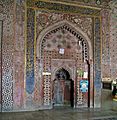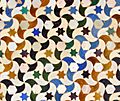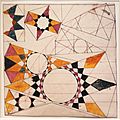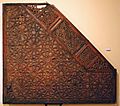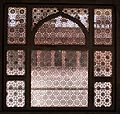Islamic geometric patterns facts for kids
Islamic geometric patterns are a special kind of art. They use many repeating shapes like hexagons, squares, and pentagons. These patterns were very important in the Arabian Peninsula and became a key part of Islamic art. They are often found in beautiful buildings and objects.
Contents
What Are Islamic Geometric Patterns?
Islamic geometric patterns are designs made from simple shapes. These shapes are repeated and combined in amazing ways. The patterns often look like they go on forever. This shows the idea of God's endless creation.
Where Did They Come From?
The ideas for these patterns came from ancient mathematics. A famous Greek mathematician named Euclid helped create the rules of geometry. Geometry is the study of shapes and spaces. These rules were later used to make the complex Islamic patterns.
Why Are They Used in Art?
In Islamic art, it is common to avoid pictures of people or animals. This is to keep the focus on God. So, artists used patterns, calligraphy (beautiful writing), and plant designs instead. Geometric patterns became a perfect way to decorate buildings and objects. They are beautiful and do not show living things.
Where Can You Find These Patterns?
You can see Islamic geometric patterns in many places. They are often found in:
- Mosques: These are places of worship for Muslims. Patterns cover walls, domes, and floors.
- Palaces: Royal buildings often have stunning geometric designs.
- Schools: Old learning centers were also decorated with these patterns.
- Homes: Even everyday items like carpets, pottery, and books have these designs.
- Glass and Tiles: Patterns are often made with colorful stained glass or ceramic tiles.
Examples of Famous Places
One famous place to see these patterns is the Alhambra in Spain. It is an old palace with walls covered in detailed geometric tiles. Another example is the Shah Mosque in Isfahan, Iran. Its domes and arches are full of colorful patterns.
How Are These Patterns Made?
Artists use tools like a compass and a ruler to create these patterns. They start with a simple shape, like a circle or a square. Then, they divide it into smaller, equal parts. By repeating these steps, they can make very complex designs. It's like solving a puzzle with shapes!
Different Types of Patterns
There are many kinds of Islamic geometric patterns. Some common ones include:
- Stars: You can find stars with 6, 8, 10, or even 12 points.
- Grids: These are patterns made from straight lines crossing each other.
- Rosettes: These look like flowers or circular designs.
- Interlacing: Lines or shapes appear to weave over and under each other.
These patterns are not just pretty. They show a deep understanding of math and art. They have inspired artists for hundreds of years.
Images for kids
-
Somewhat geometric motifs such as the Wolf's Mouth (Kurt Aǧzi), to protect the flocks against wolves, are often woven into tribal kilims.
-
A tessellation of glazed ceramic tiles forming colourful geometric patterns in the Alhambra, Spain, which inspired M. C. Escher
-
Tessellations, arabesques and calligraphy on a wall of the Myrtle court, Alhambra, Granada, Spain
-
Tomb towers of two Seljuk princes at Kharaghan, Qazvin province, Iran, covered with many different brick patterns like those that inspired Ahmad Rafsanjani to create auxetic materials
-
Two-dimensional designs for two quarter-dome muqarnas – as a seashell (top), as a fan (bottom). Topkapı Scroll, 15th century
-
Analysis of octagonal patterns in Mughal architecture by Ernest Hanbury Hankin, 1925. 8-pointed stars emerge (lower right) where heavy black lines cross.
-
Decoration in Tomb of I'timād-ud-Daulah, Agra, showing correct treatment of sides and corners. A quarter of each 6-point star is shown in each corner; half stars along the sides.
-
Safavid bowl with radial and circular motifs, Persia, 17th century
-
Glazed tilework Girih at Shah-i-Zinda in Samarkand, Uzbekistan
-
Side of a wooden Minbar (pulpit) with 12-point stars. 14th century. Turkish and Islamic Arts Museum
-
Jali pierced stone screens at the tomb of Salim Chishti, Fatehpur Sikri, India
-
Iron gate with 10-point stars and kites at Al-Rifa'i Mosque, Cairo (1869–1912)
-
Geometric shabaka stained glass in the 1797 Palace of Shaki Khans, Azerbaijan
See also
 In Spanish: Patrones geométricos islámicos para niños
In Spanish: Patrones geométricos islámicos para niños





